Results can support potential management options like size limits, quotas and seasonal closures
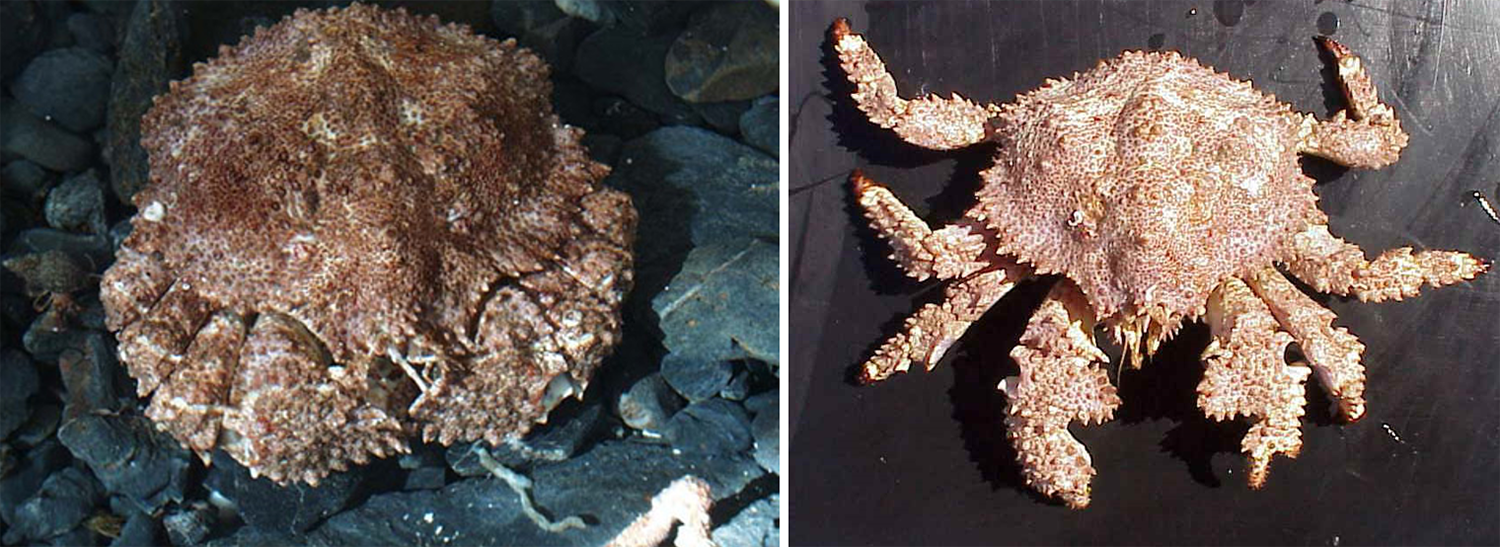
In recent years, southern California commercial fishermen have expanded fishing effort for the brown box crab (Lopholithodes foraminatus), a relative of king crabs, to diversify their businesses and take advantage of new marketing opportunities.
Fishing for the brown box crab is not new; the species has been commercially landed throughout its distribution along the eastern Pacific coast of North America for decades.
Historically, coastwide landings have been small and incidental to other fisheries. Spikes in brown box crab landings, although rare, typically resulted when effort shifted to deeper fishing grounds in search of target species, as has occurred with other crab species.
But a new market demand for and increased landings of brown box crabs, however, have raised some concerns. A designated fishery for this species did not exist; thus, only incidental take, not targeted take, was permitted. To address this issue, the California Department of Fish and Wildlife (CFDW) designated the brown box crab as an emerging fishery and limited incidental harvests and also implemented an experimental fishery program (EFP) for the brown box crab. The EFP provides 4 years to evaluate and determine whether a commercial fishery is feasible. Making this determination requires having the necessary information with which to evaluate the sustainability of the resource. Such information includes but is not limited to estimates of biomass, sustainable yield, movements, growth, and reproduction.
This article – summarized from the original publication (Stroud, A. et al. 2024. Size at maturity, reproductive cycle, and fecundity of the southern California brown box crab Lopholithodes foraminatus and implications for developing a new targeted fishery. Marine and Coastal Fisheries Volume 16, Issue 3, June 2024 e10291) – examined the reproductive capacity of southern California brown box crabs, investigating size at maturity, fecundity, reproductive cycle, brood duration, and seasonality.
Study setup
Crab samples were obtained from and in collaboration with commercial fishermen participating in the brown box crab EFP. Samples were collected from the Southern California Bight, south of Point Conception and north of the Mexican border, including both island and coastal mainland areas at depths ranging from 120 to 245 meters. Data were collected over three years (2018–2021), excluding a five-month period (March–July 2020) that was impacted by research and travel restrictions associated with the COVID-19 pandemic. Each participating fisherman provided a monthly sample of 15 males and 15 females as weather permitted; supplemental samples of small crabs (<75 mm carapace width [CW]) and molting crabs were provided as available. Additional crabs were also provided by the CDFW.
For detailed information on sample collection, crab measurements and sample collection, and analyses, refer to the original publication.
Fisheries in Focus: How the mystery of the great eastern Bering Sea snow crab die-off was solved
Results and discussion
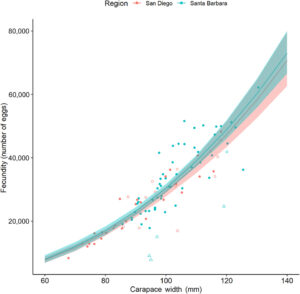
Our results provide essential biological information that can be used to inform the evaluation of a fishery targeting the California brown box crab. Female size at maturity was 68 mm CL (75 mm CW) and 79 mm CL (89 mm CW) for crabs in our study, and the smallest gravid female was 62.3 mm CL (67.8 mm CW). These comparisons follow the general pattern of size at maturity decreasing with lower latitude, a pattern that has also been reported in North Pacific populations of some king crab species.
This study provides the most comprehensive fecundity analysis of brown box crabs. We documented the highest reported egg count (>62,000 eggs) for this species and demonstrated the similarity in fecundity for crabs throughout southern California. As expected, the number of eggs increased with increasing crab size, with no indication of senescence as seen with other crab species. We conclude that the resulting size–fecundity relationship can be used to evaluate the reproductive capacity of brown box crabs throughout southern California and potentially elsewhere.
We report the first evidence for female morphometric maturity in the brown box crab. Our examination of specific body features did not coincide with maturation as determined by observation of gonad status. Although the change in female abdomen width (AW) relative to carapace width (CW) was not as readily evident as it is with other crabs, a clear relative width inflection between the two groups was consistent with physiologically based categories of mature and immature female brown box crabs. Since the morphometric differences are subtle, the presence of eggs and moss will still be the most readily available technique to identify mature female crabs in the field despite the overlap in immature and mature sizes.
Male size at maturity could only be recognized physiologically, not morphometrically or functionally. Our data confirm that male brown box crabs above 66 mm CW are mature and that maturity occurs between 47 and 66 mm CW. The large size range of physiologically mature males (47–189 mm CW) and the extremely small sample size of immature males (n = 4), however, necessitate further investigations of morphometric indicators and functional maturity to determine the size at which male crabs can successfully mate.
Our field observations of the southern California brown box crab support an approximately 18-month biennial reproductive cycle. Since (1) females must molt prior to mating, (2) molting occurs in the late summer or fall (our unpublished data), and (3) fertilization occurs shortly after mating (sperm is not stored), the occurrence of many crabs with eggs in diapause throughout the year is best explained by a 12-month diapause (delay in development in response to regular and recurring periods of adverse environmental conditions) period. The mix of some crabs with eggs in diapause and some with eggs developing and hatching in the winter and spring further suggests a staggered biennial cycle, with recently molted and mated crabs having eggs in diapause and crabs that mated in the previous year having developing or hatching eggs.
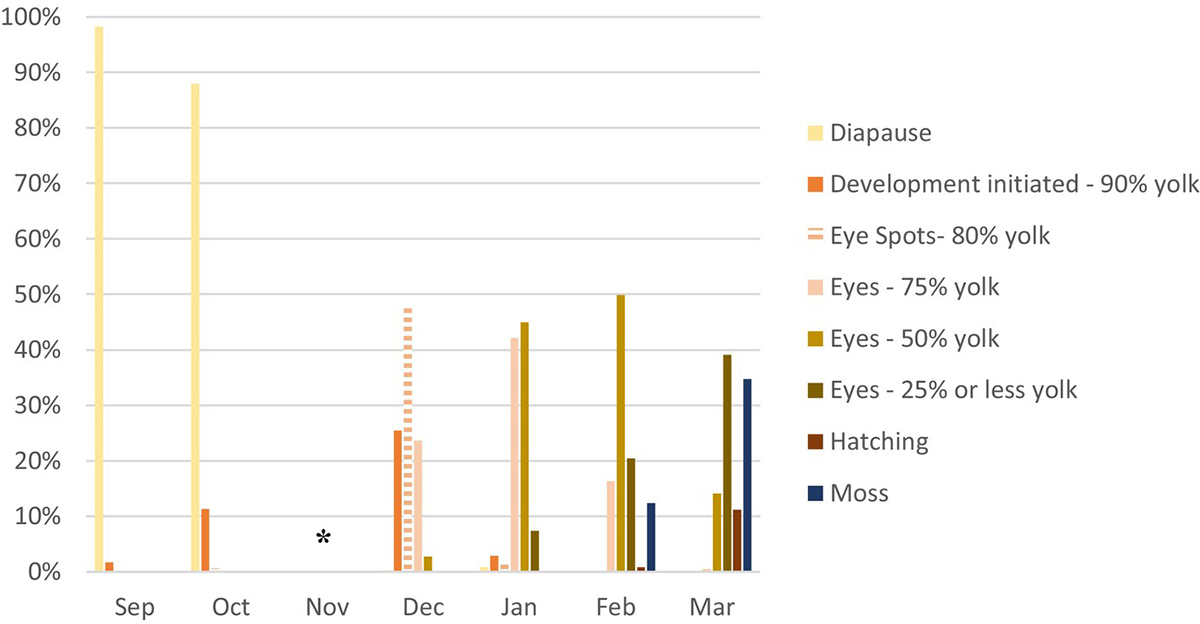
Our findings can inform the evaluation of management strategies for a fishery targeting brown box crabs. Currently, the EFP is managed primarily through the use of a size limit and a quota. The minimum legal size for brown box crabs is 146 mm maximum CW (i.e., including spines), which converts to 144.6 mm CW (i.e., excluding spines). This size limit was based largely on market demand. As female brown box crabs typically are smaller than the legal size, they are not currently being harvested and likely will not be considered for harvest in the future. As a result, females are able to contribute reproductively to the population throughout their lives.
For males, our current research supports this size limit in terms of physiological maturity, which occurs at a much smaller size, thus allowing them to contribute reproductively prior to harvest. Further, our preliminary analyses of growth rates, albeit extremely limited, suggested that male brown box crabs may be able to reproduce for many years prior to harvest. Molt increments decreased from around 16 percent for males between 62 and 98 mm CW to less than half that (~7 percent) for males larger than 125 mm CW.
Additionally, the presence of soft-shelled males in our monthly samples indicated that males likely molt only once per year. Based on these molt increments and intervals, if functional maturity is close to physiological maturity, then a 66-mm-CW male brown box crab (the size at which all male crabs were found to be mature) would have at least 5 years to contribute to the population before reaching legal size.
Although the catch size limit seems appropriate, size-selective fisheries using a minimum size can have drawbacks. By selecting for large males, there is a long-term potential for harvest to drive the population toward a smaller size at maturity and slower-growing individuals, evolving toward a small body size and lower fecundity. Some fisheries have implemented a slot limit restricting harvest to intermediate sizes, a measure that allows reproduction prior to harvest while also protecting the genetics and reproductive potential of the larger individuals. Future studies on growth rates and mating success would help to inform the determination of the most appropriate size limits for a sustainable fishery.
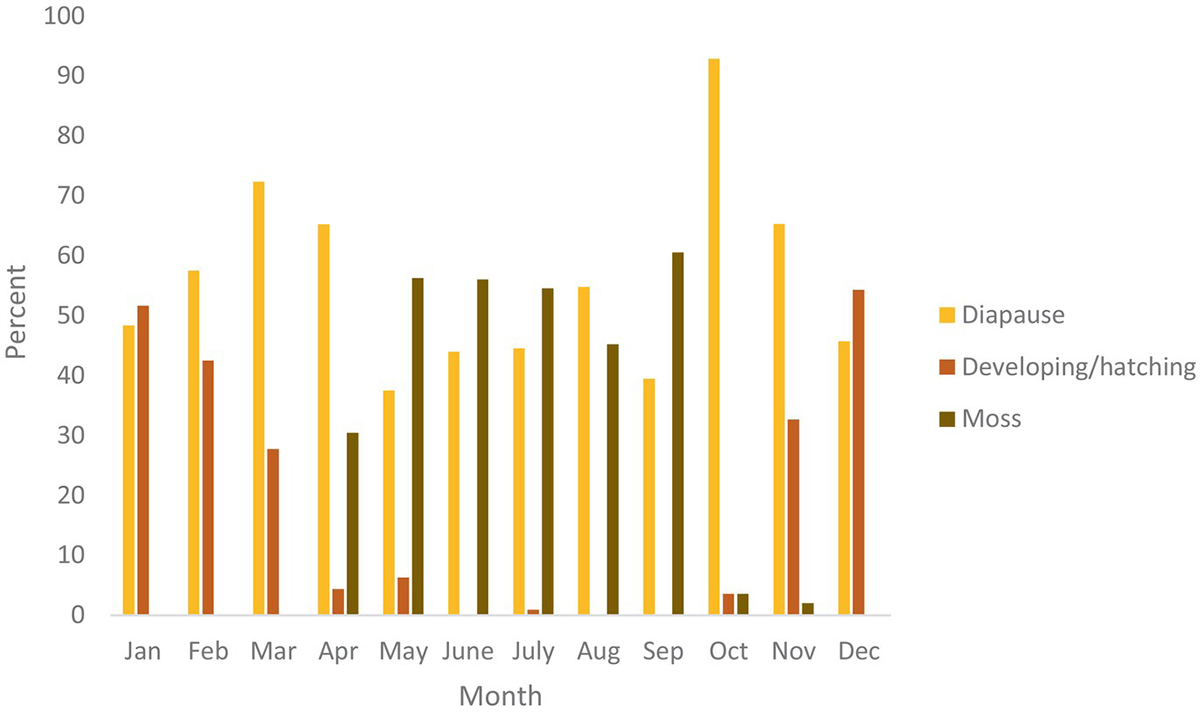
Another management strategy that could be considered is seasonal closure. Many fisheries use seasonal closures to protect stocks when crabs are molting and/or reproducing (mating; eggs hatching). Since female brown box crabs are not of harvestable size and thus are not retained, protection of the hatching season is likely not needed. Instead, closing the fishery during the molting and mating season might be considered. Given that molting and mating are basically synchronous and quite seasonal, a short-term closure during September and October may be sufficient to protect the majority of the mating/molting population if additional measures are required. Given that fishermen select for heavier, hard-shelled brown box crabs to maximize meat return, such a closure could have the added benefit of preventing low-quality crab from entering the market. The specific timing and duration of the closure would need to be periodically reassessed in light of ongoing environmental changes that may impact molting seasonality and, thus, mating seasonality.
Lastly, if California brown box crabs do indeed have limited movement, another option could be rotational zone management. Density can play a large role in the reproductive potential of marine organisms. Populations with a low density of reproductive males may lead to lower reproductive success due to limited sperm transfer from increased mating delays and decreased mating encounters associated with higher mate search and encounter times. Use of rotating area closures could help to slow the reductions of localized densities, as seen with the sea cucumber fishery.
Overall, investigations of brown box crab movement by resource managers, together with investigations of density-dependent reproductive success (e.g., tracking the number of barren mature females), are needed to better understand the potential utility of this management strategy for the brown box crab fishery.
Perspectives
Our findings provide information on the reproductive capacity of brown box crabs, which is needed for evaluating the feasibility of a targeted fishery for this species. Study results will inform discussions about potential management options, such as size limits, quotas, and seasonal closures. The results may also be used to develop models (e.g., eggs per recruit and spawning potential ratios) for assessing stock condition.
The experimental fishery program, or EFP, for brown box crabs provided a unique opportunity to collect information prior to having a large-scale fishery underway. Valuable data have been collected, but research was limited for a variety of reasons. The continued strong market for the brown box crab suggests that such a fishery will likely be economically viable.
However, questions remain about how sustainable the population will be as large males are harvested, and which management strategies will be most effective in light of this and other biological characteristics. More information is clearly needed to evaluate the potential for a long-term fishery for brown box crabs in California and elsewhere.
Now that you've reached the end of the article ...
… please consider supporting GSA’s mission to advance responsible seafood practices through education, advocacy and third-party assurances. The Advocate aims to document the evolution of responsible seafood practices and share the expansive knowledge of our vast network of contributors.
By becoming a Global Seafood Alliance member, you’re ensuring that all of the pre-competitive work we do through member benefits, resources and events can continue. Individual membership costs just $50 a year.
Not a GSA member? Join us.
Author
-
Dr. Carolynn S. Culver
Corresponding author
Marine Science Institute, University of California Santa Barbara, Santa Barbara, California, USA; and California Sea Grant, Scripps Institution of Oceanography, University of California San Diego, La Jolla, California, USA
Tagged With
Related Posts
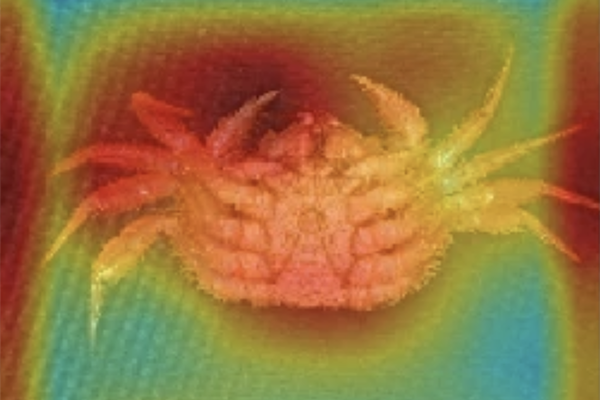
Fisheries
AI-powered crab gender identification could improve fishery management and conservation
An AI-powered model developed by researchers "vastly outperformed" humans in correctly identifying the gender of horsehair crabs.
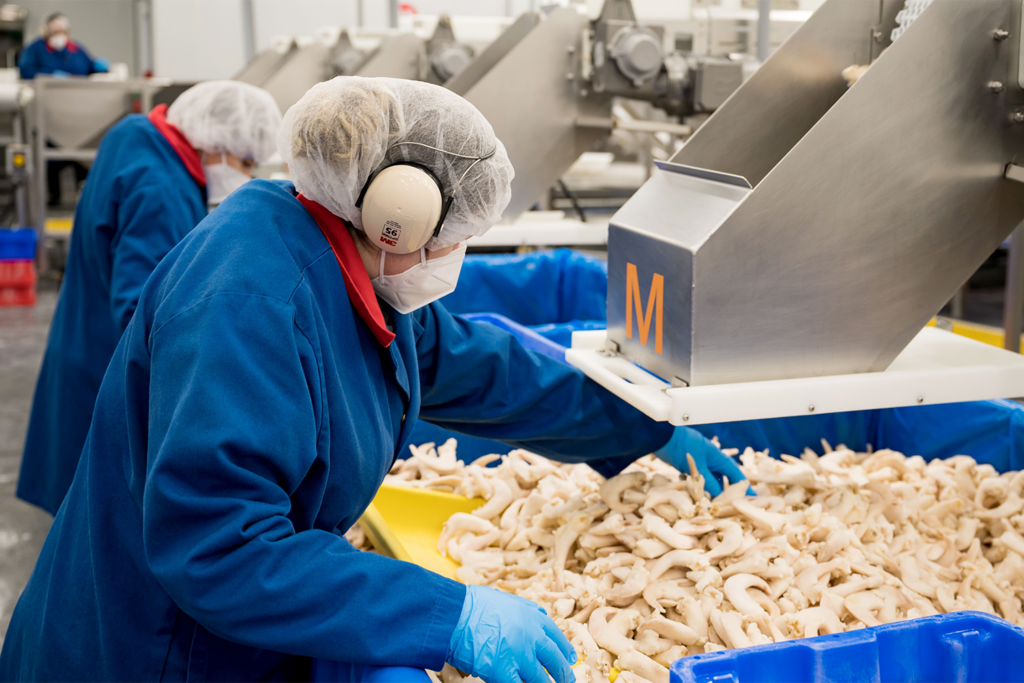
Responsibility
‘Building towards abundance’: How Indigenous-owned Clearwater Seafoods is reshaping Canada’s seafood industry
The Mi’kmaq Coalition’s 50 percent acquisition of Clearwater Seafoods is transforming Canada’s seafood industry and promoting responsible fisheries.
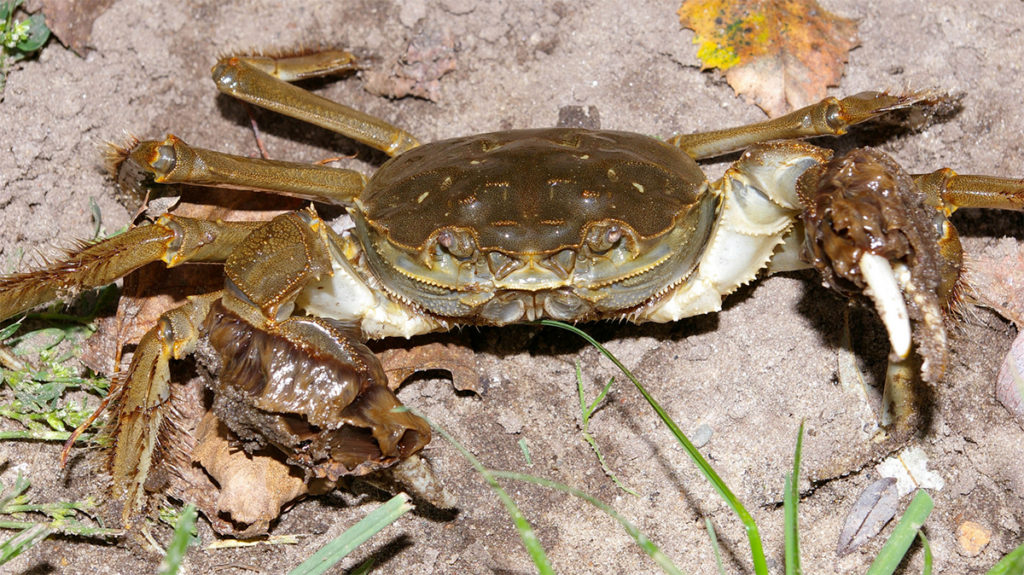
Health & Welfare
Effect of stocking density during overwintering culture of Chinese mitten crabs
Study evaluates stocking densities for overwintering Chinese mitten crabs, an important aquacultured species in China, to extend the production season.
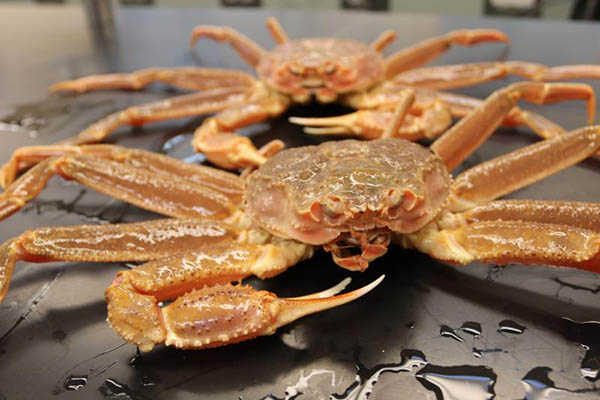
Fisheries
NOAA confirms link between snow crab decline and marine heatwave
Starvation is most likely the cause of a mass mortality event during the eastern Bering Sea marine heatwave, according to NOAA scientists.



